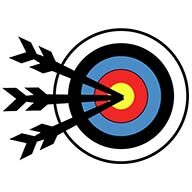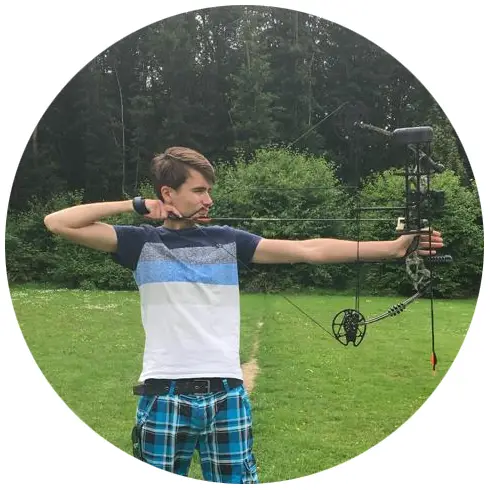People that have never touched a bow often believe that archery is all about aiming. It seems logical since you are firing a projectile, like most other shooting sports. Archers, however, often explain that aiming isn’t that big of a deal and that it mostly comes naturally. Your technique and form tend to be a lot more important and require a lot more work.
Therefore we often don’t pay any attention to how we are aiming and how we could improve our aiming. There are, however, still some small adjustments you can make to improve your aiming, which can have a dramatic impact. I will, therefore, give you 7 tips that can make aiming a lot easier in this article.
Use a stabilizer
The easiest way you can improve your aim is by using a stabilizer. This is such a good and easy solution, that most archers already use this device. So if you are not using a stabilizer yet, I would highly recommend doing so. The stabilizer will reduce the amount of vibration of the bow when you are aiming. Vibration is one of the major challenges that make aiming a bow quite difficult. This will cause the sight pin to shake, which makes it really difficult to aim at the center of the target. Additionally the shaking may cause distraction. Therefore any device that can reduce this is worth a try.
I would highly recommend using the long stabilizer, with the two side stabilizers since they all remove vibration of the bow in different directions. Another benefit of the side stabilizers is that they tend to balance out the bow, which makes it more easier to wield. I have written an in depth article about stabilizers, I would highly advice checking it out, if you are not using a stabilizer yet:
Stabilizers – how they work and what to buy
Shoot a lower poundage
Pitfall number one amongst archers is to overestimate your own abilities and buy a bow with a too heavy poundage. I have seen so many archers that have bought a too heavy bow, which hinders them to aim correctly. When you have a bow with a too heavy poundage, you will start to shake which can really mess up your aim.
Another reason why a heavy poundage can hold you back is because you might hurry your shot. When you experience muscle fatigue archers tend to spend less time at full draw. Since you can only aim properly at full draw, you have less time to aim. The longer you take too aim the better your shots tend to get, since you have more time to correct for vibration. That’s why compound archers often aim for quite a while.
You should never use a bow that you can just barely draw. When you are maxing out your muscles, you will have less control over your movements and you might hurry the shot. Therefore, especially at short distances, shooting at a lower poundage can be a huge advantage. Training your muscles can also be a great idea, because stronger muscles have more control. If you want to know how to train your muscles for archery, I would highly recommend reading this article:
How to train your back muscles for archery
Improve you sight picture
Most archers start with an inexpensive sight, since getting into archery can be quite an investment. In general I believe getting cheap gear isn’t often hindering your performance. Therefore there is nothing wrong with starting with a cheap sight. Although a more expensive sight has some features that allow you to make finer adjustments, you could do the same with a cheaper sight, it’s only more inconvenient.
Most sights come with an aperture that is quite small with a sight pin that is rather large. This can make aiming more difficult since more of the field of view is blocked by the aperture and sight pin. Although some archers like a large sight pin and small aperture due to eye conditions, most archers benefit from changing to a more advanced aperture. I especially like the big apertures with a small floating sight pin. They restrict your field of few as little as possible and make you able to see the full target.
In my article about sights, I discuss all important aspects you should consider when buying or upgrading your sight. So I would highly advice reading that article if you consider upgrading your aperture or sight:
How to pick the right sight for your bow – recurve archery
Shoot with two eyes open
When I learned archery all coaches told me that you should close your left eye (if you’re a right handed shooter). Most professional archers, however, shoot with two eyes open. The advantage of shooting with two eyes open is very simple; you have better vision using both of your eyes. If you have ever been to an optician for an eye exam, you might have noticed this. When you open both of your eyes, the eyes work together to create a clearer image.
Shooting with two eyes open, however, is not as simple as it seems. When your eyes work together, most often one eye is dominant. This means that you see the world from the perspective of one of your eyes, while you other eye improves the image. The whole process is quite complicated, but for archery eye dominancy is very important.
If the eye you aim with isn’t your dominant eye, you might have trouble with shooting with two eyes open. Since the image of the sight will be shifted to the right (for right handed shooters). This means if you would shoot with two eyes open, you would shoot on the left of the target. When the eye your are normally aiming with is your dominant eye, you won’t experience any of these issues and you will only reap the benefits of the improved clarity of your sight. Therefore, I would highly suggest trying to shoot with two eyes open. If you want to know more about eye dominancy and want to know which of your eyes is dominant, I would highly suggest reading this article from All About Vision:
Dominant eye test: how to find your dominant eye
Avoid eyestrain
In the last two tips, we already discussed how important your sight picture and the clarity of your field of view are. Another thing that will decrease the clarity of your sight is eyestrain. This issue can especially be prevalent if you are shooting outdoors. Your eyes can’t take bright light well, therefore it’s a good idea to use sunglasses or block the light with a hat. The bright light will strain your eyes, which makes it more difficult to focus decreasing the clarity of your field of view.
Also indoor archers should consider eyestrain. Although you won’t have issues with bright light from the sun, there are a lot of other things that can strain your eyes. For example looking at your phone or any other screen for too long can really strain your eyes. You should also make sure that you are not constantly focused on a specific object. If you only stare at the target, your eyes will be strained, which will be a disadvantage when you are aiming. Therefore, it’s a good idea to use the breaks to let your eyes rest, since aiming can be quite strenuous for your eyes.
Shoot relaxed
In a previous tip we discussed that you should always aim relaxed. It’s, however, a best practice to be relaxed the entire shot process. If you shoot a lot of arrows in a short time, you will strain your muscles more. When you are taking more time between shots you give your muscles a little time to rest. Although it might seem that these few seconds might not help, in my experience it really helps to prevent muscle strain. Muscle strain eventually leads to shaking which decreases your accuracy.
Especially in archery competitions those minor changes can make a big difference. That’s why you often see target archers use almost the full 1 minute and 30 seconds that they are allowed to use. If you are shooting all 3 of your arrows within 1 minute, you could give your muscles about 10 seconds additional resting time.
Even if you are a recreational archer, you are probably not focused on your arrows per minute. Except when you are Lars Anderson of course ;). Modern archery is not about the amount of arrows you shoot, but it’s all about accuracy of the few arrows you do shoot.
Avoid target panic (flinching)
Although it’s good to work on your aiming technique, you shouldn’t obsess over it. When you are focusing too much on aiming at the center of the target, you might experience a thing that is known as target panic. This happens when you anticipate the shot too much which makes our muscle contract uncontrollably. Outside of archery, this issue is often called flinching. In general I don’t really like the word target panic, since it also often happens when you are overconfident.
Some devices reduce the flinching, like the clicker for a recurve archer or a back tension release for a compound archer. These devices, however, will never completely eliminate flinching. A more easy way to reduce flinching to a minimal is by using a few mind tricks. Since flinching happens when you anticipate the shot too much, you should try to focus on something else, like your form and technique.
You shouldn’t focus too much on where you are exactly aiming; you will aim at the center of the target instinctively. Another pitfall is to focus too much on your scores. If you are thinking about what score you need, you probably will force your release, causing you to flinch.
Do you want to know more about flinching like: what is causes; how to avoid it and; how to break the habit? Then I would highly recommend reading the following article:
How to prevent flinching in archery
Final words
The seven tips from this article are all based on my own experience and the experience of archers around me. These seven tips really helped me with aiming, so I hope they work for you too! If you have any tips yourself, I would love to hear them in the comments below. Questions are also welcome of course. I will answer as soon as possible.
Tim van Rooijen
For as long as I can remember, I have always been fascinated by archery. First due to its historic significance but later because I like being outdoors. With this blog, I share my knowledge about Archery and how you can improve your shot. More about author…

